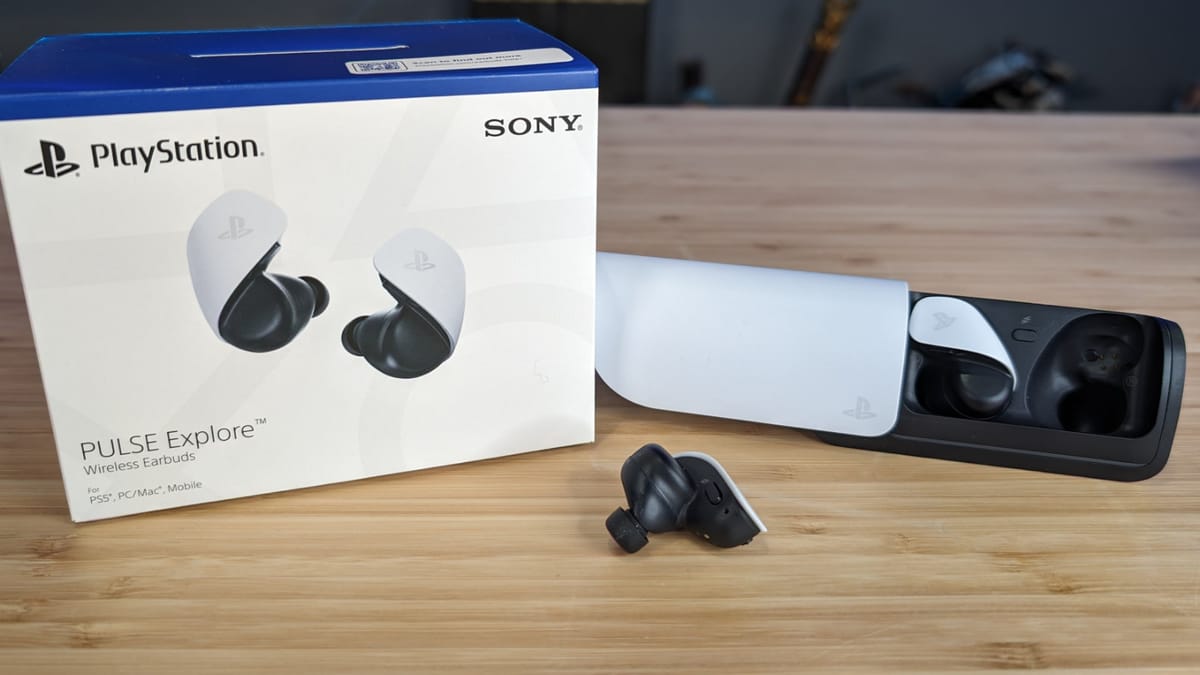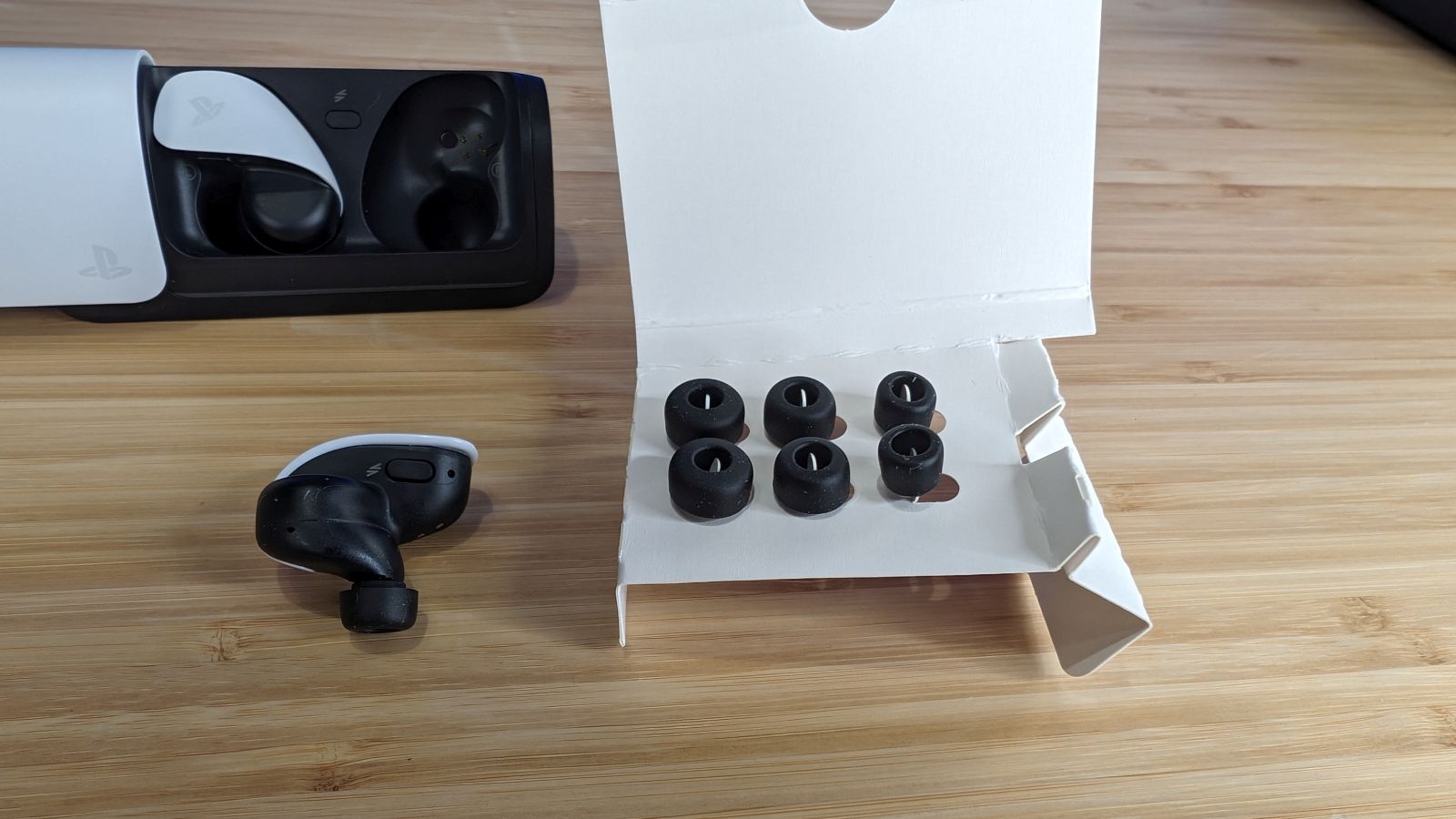
Sony doesn’t make a lot of peripherals, so when they do it’s best to pay attention. Whether you choose to pair them with your PlayStation VR2, PlayStation 5, or brand new PlayStation Portal, or link them with a Steam Deck, Nintendo Switch, or all of the above, this gaming audio solution is a cut above. Let’s dig into the details on the Sony PULSE Explore wireless earbuds.
Opening the box, there are a handful of things inside. Naturally, the PULSE Explore wireless earbuds and their rather unique charging case (more on that in a moment), but also a PlayStation Link USB adapter, a USB-C cable, the instructions, and a selection of six additional earbud tips to adapt these earbuds to fit just about any sized ear.

The charging case uses the same color scheme as the PlayStation 5, which should come as no surprise. It also has much of the same rounded appearance. The housing slides off to one side, revealing the earbuds underneath, as well as the synchronization button, and an indicator light to tell you whether the device is pairing, charging, or powering up. Tapping the sync button causes the light bar to blink, pairing the device with just about anything that’ll accept a Bluetooth connection.
With the sleek curves of the PlayStation 5, it’s no surprise that the PULSE Explore earbuds are equally as stylized. For lack of a better descriptor, they are shaped like a comma. A thin curved white shell covers the top all the way to the bottom, with a volume rocker on the rear, a sync button on the opposite side, four metal contact charging points, and a right and left designation on each. It’s what this simple but sleek design hides that makes all the difference.

The PULSE Explore utilizes planar magnetic drivers. If you are unfamiliar with the tech, planar magnetic drivers utilize a thin flat diaphragm with a wire running through it. An electromagnet is then suspended next to that diaphragm, and by rapidly charging and discharging said magnet, a reaction in the diaphragm creates sound. This is in contrast to a more traditional dynamic driver where typically a pair of wires around a paper cone creates larger but slower movements. If you’ve ever listened to headphones that sound muddy or tinny, there’s a very real chance that they’re dynamic. Audiophiles prefer planar drivers for a reason, but they also typically have one big drawback – size. Sony has somehow cracked that problem. I guess it shouldn’t come as a surprise as they’ve created more than a few technologies including DVD, LDAC, the Walkman, and co-created Blu-Ray, just to name a few.
The other big problem with planar drivers is that they don’t always deliver rich and thumpy bass. Again, Sony has delivered in a big way with the PULSE Explore. These earbuds not only deliver a warm bass sound, it’s also remarkably clear. Rather than just vibrating your ear canal, these earbuds thump. Again, I shouldn’t be surprised, as Sony purchased Audeze in 2021 – a company known for, you guessed it, planar magnetic drivers.

I’ve tested quite a few earbuds at a wide variety of price points, and there are certainly levels that you hit where new features appear. At $200, these offer an incredibly rich sound across the board, but they don’t offer active noise cancellation – that’d require at least an additional c-note, from my experience. They also don’t have a companion app to tune the sound profile, though they’ve offered up that there will be “further enhancements” on the PlayStation 5 in the near future.
I was surprised to see the connection method to Sony’s own hardware – a USB dongle. Dubbed the “PlayStation link USB Adapter”, this included adapter plugs into an open USB-A port on the console. With the dongle plugged in, the earbuds immediately connected with a quick tap of the sync button on the case. I would have imagined the PS5 would connect to the device without the need for an adapter, but that could also be a function of providing that low latency connection.
Utilizing them on my Steam Deck and Nintendo Switch was as simple as it gets. Plugging into a PC via the dongle, it worked like a charm. To connect it to my Steam Deck or Nintendo Switch I needed to pull a USB-A to USB-C adapter into the mix, but it also connected instantly. Putting the dongles aside, however, I wanted to check run-of-the-mill Bluetooth connectivity. Holding in the sync button for 8 seconds caused it to show up instantly for any device I pointed it at, ready to go instantly. These aren’t just for your Sony gear, these are for everything you’ve got.
With wireless earbuds and gaming, regardless of driver type, latency is a concern. Testing with Call of Duty: Modern Warfare III, Chivalry 2 (the peasant shrieks are the best), and No Man’s Sky, and all in multiplayer, I was able to get a good feel for how the PULSE Explore performs with friends. Unsurprisingly, these delivered in a big way. I couldn’t detect any latency whatsoever, and all of my sessions were crystal clear.

In a year where every headline and product involves AI in some way, it’s no surprise that the PULSE Explore does as well. Utilizing AI for active noise rejection, the microphone analyzes the sound profile, scrubbing noise spikes and loud sounds without the need for any user intervention. It also does a great job of cleaning the ranges of a normal human voice, meaning you’ll sound crisp and clear. It’s wholly unscientific, but everyone on the receiving end said I sounded fantastic.
In terms of battery life, I found the PULSE Explore delivered what was promised – about five hours of battery life at a reasonable volume. The case underbelly lists them at 250 mA *2, and the case itself at 780 mAh/3.0 Wh, so that math equates to roughly another dozen or so hours of charge.
The price on the Sony PULSE Explore is $199, which is actually fairly reasonable for earbuds with active noise cancellation and lossless sound quality. I do wish it had longer than a one year warranty, especially at the price point, though.
Ultimately, I found that I liked throwing these into my ears rather than using the included wired earbuds for the PSVR2. It also worked incredibly well for games like Ghost of Tsushima, bringing the wonderful traditional flute music to life with a whole and rich sound that reminds me why we loved that game so much in the first place.
Sony PULSE Explore wireless earbuds
Excellent
There are a lot of fantastic audio solutions out there that’ll work for your PlayStation 5, PSVR2, and all of your other devices, but none that I can easily think of that sport Planar Magnetic Drivers, or this much bass. The AI-powered noise rejection is a wonderful surprise, as is the ease of how it all connects. Sure, the dongle is a bit of a head scratcher, as is the shorter warranty, but wow do these sound good. The fact that it works on literally everything is just icing on the cake.
Pros
- Sleek and unique look and feel
- Works with everything I could throw at it
- Planar Magnetic Drivers are unheard of in this form factor
- WOW these sound fantastic
Cons
- No ANC
- Why the dongle?
- 1 year warranty
